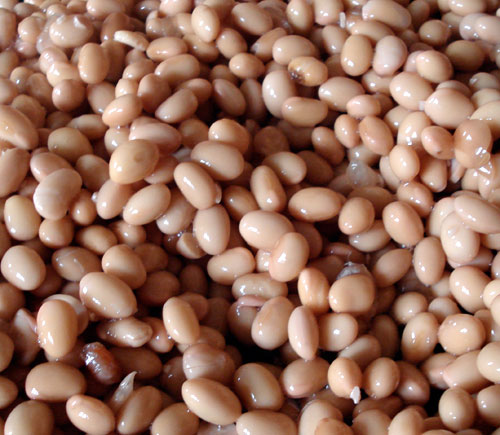
Until fairly recently I had a blind spot when it came to the humble soybean. I regularly consume soy products like soy milk, tofu and okara, not to mention fermented soybean products like natto and tempeh. And green soybeans or edamame are always a great snack.
But for some reason, I didn't really get into eating the whole dried (and cooked) soybean. It's not that they are that much harder to cook than other dried beans either.
In any case, I've rectified that situation and now I cook up a batch of soybeans quite regularly and store them in the freezer. Plain boiled soybeans are amazingly delicious, and just packed with nutrition. The cooking liquid is so rich that it can be used as a very nutritious stock or dashi for making soups and such.
There are a couple of points to watch out for when cooking whole soybeans, which are noted below in copious detail.
Filed under:
basics japanese ingredients legumes vegan
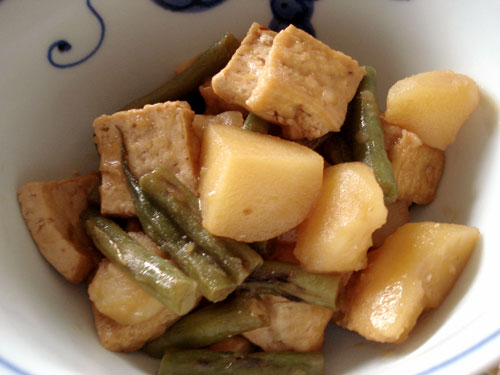
_Nikujaga_, stewed potatoes with meat, is a staple of Japanese home cooking. It's filling and comforting, and appears quite frequently for dinner at our house. Recently though I've been making this vegan version more frequently, which is just as tasty as the meaty version. Thick fried tofu (atsuage) is the protein replacement, but it's not just there for it's nutritional benefits - I love the texture in a lot of dishes.
The recipe, plus some ideas on how to reform Japanese non-vegan recipes to make them vegan, after the jump.
Filed under:
japanese potatoes vegetarian favorites vegan
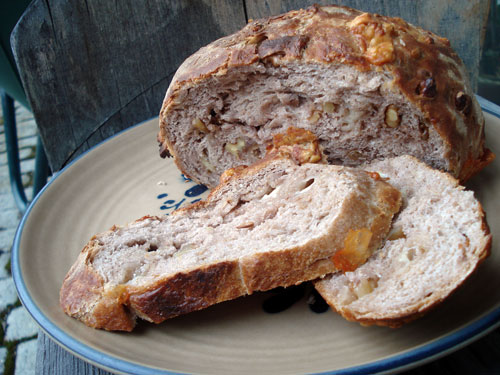
Notes on the Almost No-Knead Bread method, plus a recipe for bread with wine in the dough.
Filed under:
bread baking favorites

Continuing my _yohshoku_ mini-marathon, here's the infamous Japan-ized pasta dish called Napolitan or Naporitan. (Japanese doesn't have an L or R sound, which is why Japanese people often mix them up when speaking Western languages.) As far as I know, there's nothing remotely Neapolitan about Napolitan, except for the use of spaghetti. It is made with a creamy ketchup-based sauce, and has the salty-sweet flavors that Japanese people love.
Filed under:
japanese yohshoku pasta

While I make Japanese style hamburgers all the time, I rarely make menchikatsu, its breaded and deep-fried cousin. I guess it's the breading and deep frying that deters me - it's a messy process, and I'm not sure it's worth the effort. So I made these ones for the blog! Fortunately they were consumed very eagerly.
Filed under:
japanese yohshoku meat
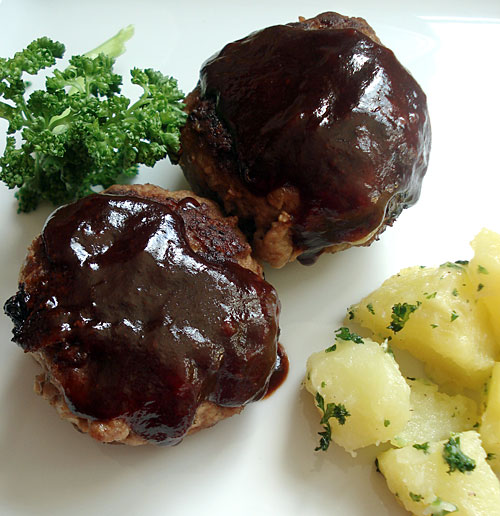
As promised, here is my recipe for making Japanese style hamburgers or hamburger steaks, one of the quintessential _yohshoku_ or Japanese Western-style dishes.
They are called hanbaagu (though they are sometimes called hambaagaa, but that variation usually refers to the kind that comes sandwiched inside a bun) in Japan, and are very popular for lunch or dinner, and are eaten as a side dish to rice (okazu) in Japanese homes. In fancier restaurants that specialize in yohshoku, they might be eaten with a knife and fork, but at home they're eaten with chopsticks. Whenever Japanese food magazines have a poll about popular okazu, hamburgers are always in the top three, especially amongst kids.
They don't have much in common with the American style of hamburger, except for the fact that they both start off with ground meat. A Japanese hamburger has more in common with meatloaf, and a rather similar texture. They are similar to the old TV dinner standby, Salisbury steak, but I think a lot better.
Filed under:
japanese yohshoku favorites meat
I am still not up to much cooking, but I did want to share this in case anyone ends up making the hot cross bunny buns, or just regular hot cross buns, for Easter, and have leftovers. I did the trial run for the bunny buns a couple of days before I went to the hospital. Eight (!) of them were consumed almost right away, but the rest ended up getting hard and forlorn since (cough) someone forgot to put them in the freezer fast enough.
Never fear though, they made great bread pudding. It was so good that even I was able to eat a little, in my current uncomfortable-swallowing and lack of appetite state.
Sorry for the lack of photos...it got devoured before I had a chance to shoot. I'll put some in next time I have leftover hot cross bunnies.
Filed under:
bread easter leftovers
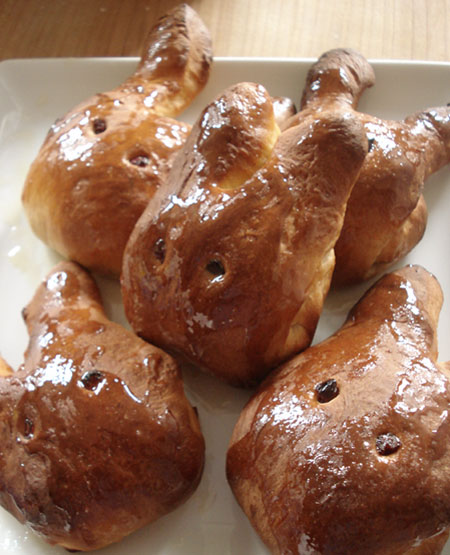
I love bunnies, and Easter is a great excuse to make something edible in a bunny shape. Last year, I made bunny bao. The year before that, I took a class in making chocolate bunnies. I've also made pastel colored Easter Bunny cupcakes, and given you a diagram for cutting _usagi ringo_ (apple bunnies).
This year I have an urge for the traditional British Easter treat, hot cross buns. But, as bunnies.

Hot Cross buns are soft and light, spicy fruity buns with a sugar glaze. They are called Hot Cross buns because they usually sport a cross on top. I prefer the bunny as my Easter motif.
These bunnies are made using the Hot Cross bun recipe on the BBC Food site, which yields a realy nice, light bun with a wonderful spicy fragrance. I did change two things: I added some orange zest in addition to lemon zest to the dough, and simply pressed some dried fruit into the dough as I'll show below instead of mixing it into the dough. This was done in order to produce bunnies with fairly smooth faces. The drawback is that you don't get fruit in every bite, but I think the cuteness more than makes up for that.
Filed under:
bread easter bunny holidays

Even if I am Japanese, I don't like all Japanese food. And I must confess that I don't like a lot of traditional Japanese sweets that are based on sweetened beans. For the most part they are way too sweet for me, and if I make them for myself I'm always adjusting the sweetness level, as with my ohagi or botamochi.
Mitarashi dango, however, are my absolute favorite traditional sweet. They are not really that sweet really - that shiny caramel colored sauce (which is called mitarashi sauce) is sweet and savory at the same time. It goes perfectly with the bland, slightly chewy dango or dumplings. (Dango is the name for unfilled solid dumplings.)
You may see the dango just plained boiled more often than not. But grilling the dango makes them so much better, in my opinion.
Filed under:
dessert japanese party food wagashi
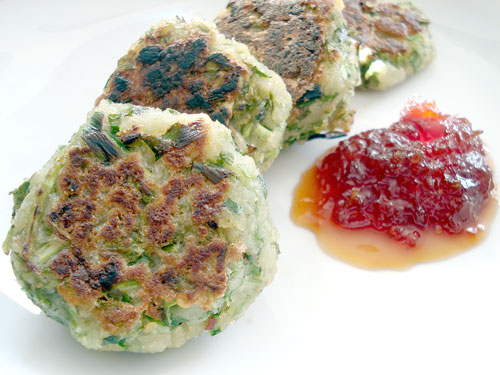
These tasty little savory cakes are made of ground lotus root. The texture is quite surprising - almost like mochi cakes. It's a great vegan, gluten-free savory snack that's high in fiber and packed with flavor.
Filed under:
party food vegetables vegetarian vegan gluten-free asian
Pages